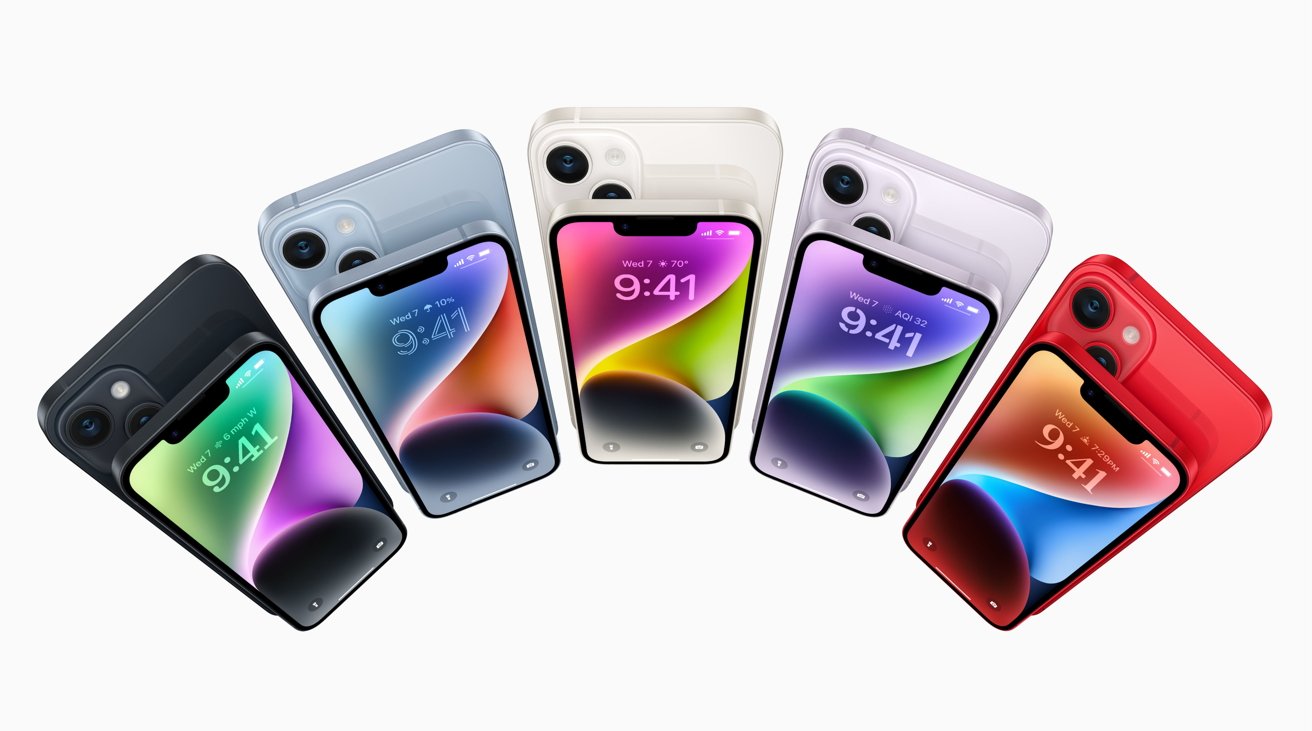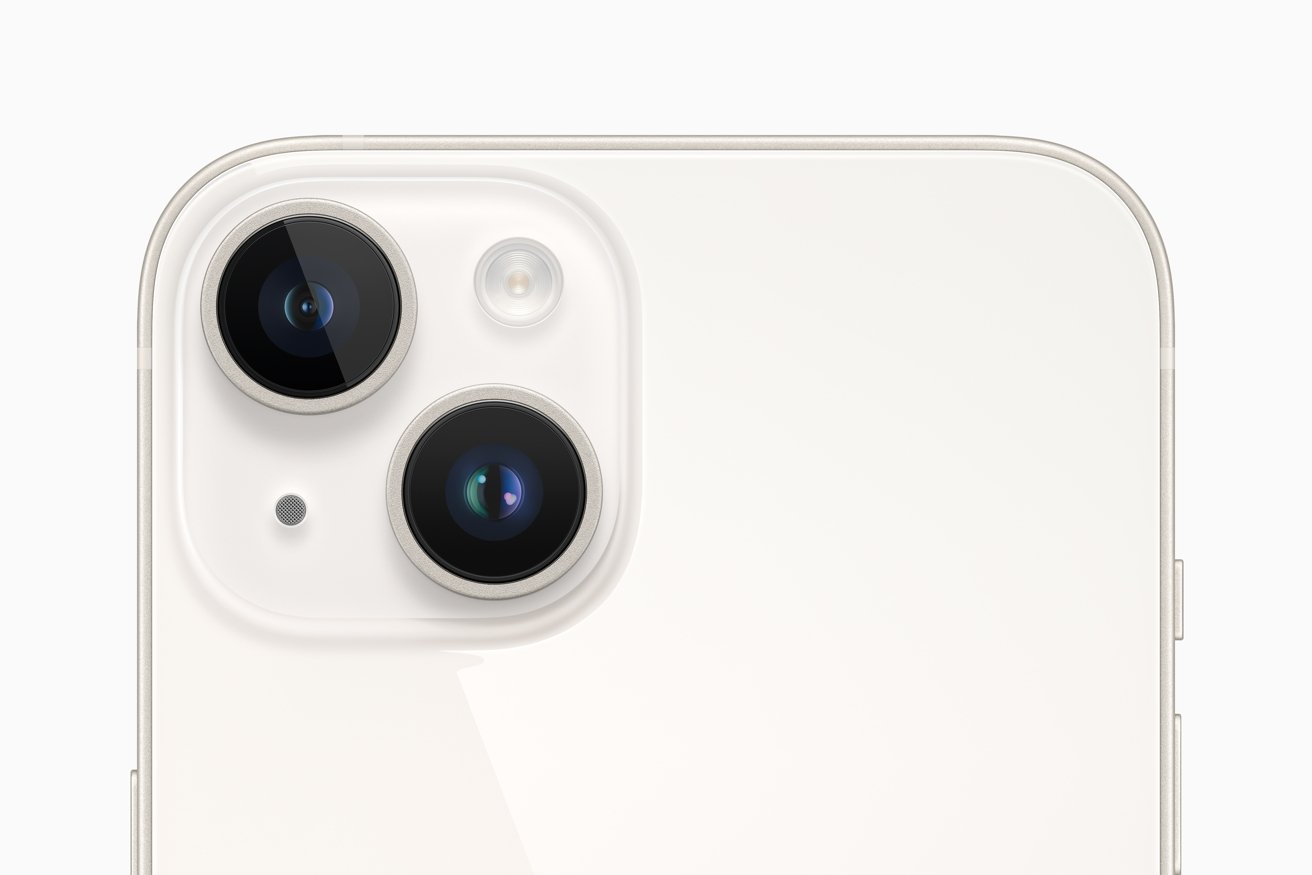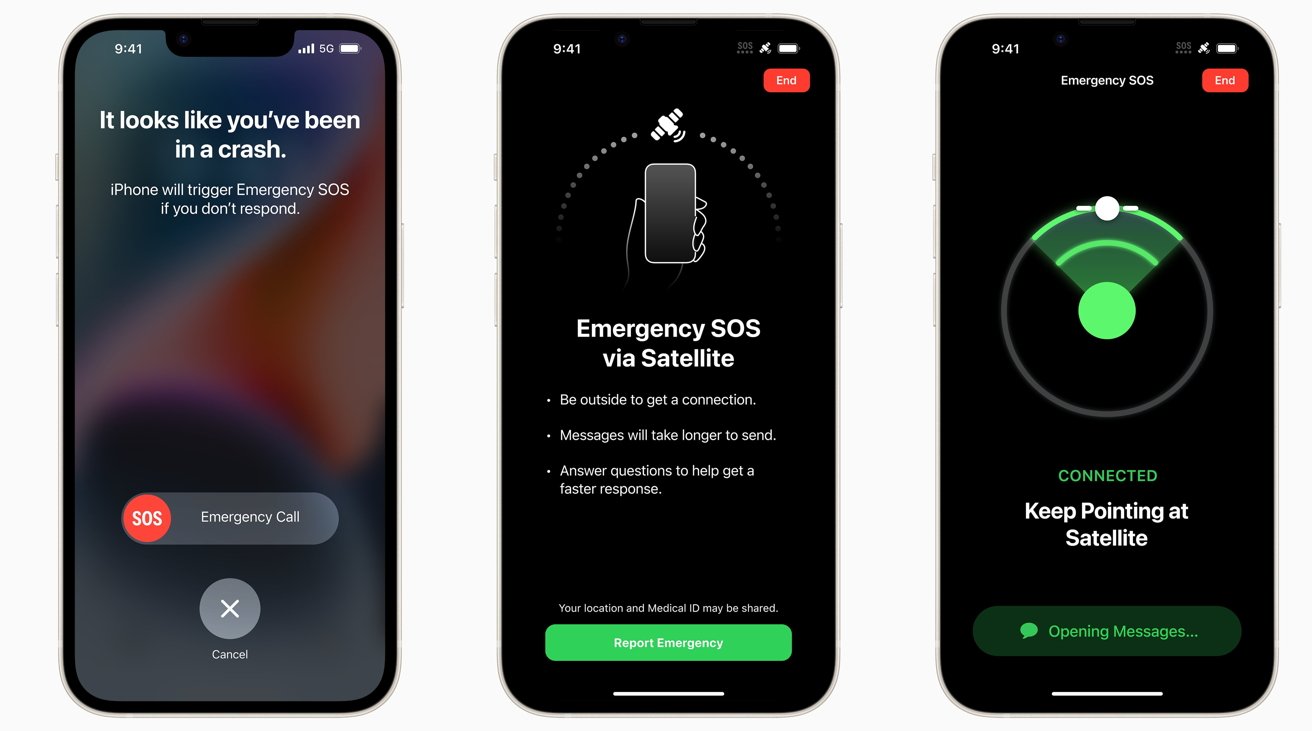Apple introduces iPhone 14 & iPhone 14 Plus -- with satellite connectivity
Apple used its Wednesday special event to unveil the iPhone 14 and iPhone 14 Plus, updates to its flagship smartphone that cuts out the mini model in favor of something bigger.

The five colors of iPhone 14
Announced at Apple's "Far Out" event, the iPhone 14 follows the iPhone 13 in the ever-growing iPhone catalog. This time, there's one big upgrade to the lineup.
Rather than offering a standard and mini model, Apple has switched the smallest smartphone for a much bigger alternative. Joining the 6.1-inch iPhone 14 is the iPhone 14 Plus, a revival of the suffix and a smartphone with a 6.7-inch display.
The Super Retina XDR display is OLED, with a wide color gamut, 2 million:1 contrast ratio, and 1,200 nits of peak HDR brightness. That HDR support covers HDR10, HLG, and Dolby Vision.
As raised in rumors, Apple is reusing the A15 in the iPhone 14 instead of using an all-new chip, albeit with "Pro-level" enhancements. This is a big departure for Apple, as it typically upgrades the chip with each successive iPhone generation.
The chip being used has a five-core GPU, a six-core GPU with two performance cores and four efficiency cores, the 16-core Neural Engine, and the Image Signal Processor.

The camera on the back of the iPhone 14
For photography, the main camera is a 12-megapixel shooter with a larger sensor, using an f/1.5 aperture and 1.9-micron pixels, as well as Sensor Shift OIS. Apple claims this results in a 49-percent improvement in low-light photography over the previous generation.
The Ultra Wide camera is also 12 megapixels, with an f/2.4 aperture and a 120-degree field of view.
Around the front, the TrueDepth Camera has been updated, with the 12-megapixel shooter having an f/1.9 aperture. Also, TrueDepth has autofocus for the first time.
Apple's computational photography has been updated by setting its Deep Fusion processing earlier in the process of taking a shot. Now known as the "Photonic Engine," this improves low-light performance and how it renders color.
Video is also improved with Action Mode, a stabilization system that uses the entire camera sensor for a less shaky shot. You still have 4K 60FPS video with HDR Dolby Vision, 30fps for Cinematic Mode, and Action Mode works at up to 2.8K at 60fps.
An unexpected change relates to SIM, as Apple is embracing eSIM even more. In the United States, the iPhone 14 will be sold without a SIM tray, requiring eSIMs instead, though SIM trays will continue to be included outside the United States.
Continuing with connectivity, Apple is introducing Emergency SOS via Satellite. Users can send an emergency text message via satellites if they are in a low-signal area.

Crash Detection and emergency messaging via satellite.
Using a compression system to reduce the size of text messages to a third, the system can send a text message in less than 15 seconds using the technology. Relay centers set up by Apple will pass on the messages to emergency providers who only deal with phone calls.
Arriving in November in the U.S. and Canada, the satellite feature will be free for two years after buying an iPhone 14.
Another emergency feature is Crash Detection, which has the iPhone detecting when a severe collision has occurred. After attempting to communicate with the owner and not getting a response, the iPhone 14 can automatically place a phone call to emergency services.
Battery life has been improved in the iPhone 14, with up to 20 hours of video playback for the standard model and up to 26 hours for the Plus. MagSafe charging also makes a return.
The iPhone 14 will start from $799, $899 for the Plus model, with pre-orders commencing on September 9. The iPhone 14 will be available from September 16, with the Plus from October 7.
Read on AppleInsider

The five colors of iPhone 14
Announced at Apple's "Far Out" event, the iPhone 14 follows the iPhone 13 in the ever-growing iPhone catalog. This time, there's one big upgrade to the lineup.
Rather than offering a standard and mini model, Apple has switched the smallest smartphone for a much bigger alternative. Joining the 6.1-inch iPhone 14 is the iPhone 14 Plus, a revival of the suffix and a smartphone with a 6.7-inch display.
The Super Retina XDR display is OLED, with a wide color gamut, 2 million:1 contrast ratio, and 1,200 nits of peak HDR brightness. That HDR support covers HDR10, HLG, and Dolby Vision.
As raised in rumors, Apple is reusing the A15 in the iPhone 14 instead of using an all-new chip, albeit with "Pro-level" enhancements. This is a big departure for Apple, as it typically upgrades the chip with each successive iPhone generation.
The chip being used has a five-core GPU, a six-core GPU with two performance cores and four efficiency cores, the 16-core Neural Engine, and the Image Signal Processor.

The camera on the back of the iPhone 14
For photography, the main camera is a 12-megapixel shooter with a larger sensor, using an f/1.5 aperture and 1.9-micron pixels, as well as Sensor Shift OIS. Apple claims this results in a 49-percent improvement in low-light photography over the previous generation.
The Ultra Wide camera is also 12 megapixels, with an f/2.4 aperture and a 120-degree field of view.
Around the front, the TrueDepth Camera has been updated, with the 12-megapixel shooter having an f/1.9 aperture. Also, TrueDepth has autofocus for the first time.
Apple's computational photography has been updated by setting its Deep Fusion processing earlier in the process of taking a shot. Now known as the "Photonic Engine," this improves low-light performance and how it renders color.
Video is also improved with Action Mode, a stabilization system that uses the entire camera sensor for a less shaky shot. You still have 4K 60FPS video with HDR Dolby Vision, 30fps for Cinematic Mode, and Action Mode works at up to 2.8K at 60fps.
An unexpected change relates to SIM, as Apple is embracing eSIM even more. In the United States, the iPhone 14 will be sold without a SIM tray, requiring eSIMs instead, though SIM trays will continue to be included outside the United States.
Continuing with connectivity, Apple is introducing Emergency SOS via Satellite. Users can send an emergency text message via satellites if they are in a low-signal area.

Crash Detection and emergency messaging via satellite.
Using a compression system to reduce the size of text messages to a third, the system can send a text message in less than 15 seconds using the technology. Relay centers set up by Apple will pass on the messages to emergency providers who only deal with phone calls.
Arriving in November in the U.S. and Canada, the satellite feature will be free for two years after buying an iPhone 14.
Another emergency feature is Crash Detection, which has the iPhone detecting when a severe collision has occurred. After attempting to communicate with the owner and not getting a response, the iPhone 14 can automatically place a phone call to emergency services.
Battery life has been improved in the iPhone 14, with up to 20 hours of video playback for the standard model and up to 26 hours for the Plus. MagSafe charging also makes a return.
The iPhone 14 will start from $799, $899 for the Plus model, with pre-orders commencing on September 9. The iPhone 14 will be available from September 16, with the Plus from October 7.
Read on AppleInsider


Comments
Kidding aside, I'm in the same boat. Have a 12 mini and still have my original SE hanging around the house, and I'm shocked at how small and pocketable that thing is. I appreciate a larger size when I'm lounging around with my phone, but I miss the smaller size when I'm on-the-go and trying to one hand it. This is why I have an iPad and a laptop for more substantial use scenarios.
Unless perhaps the satellite texting capability does not support iMessage, and the satellite data is all unencrypted for the world to see. Then maybe dictatorships won't object. But if so, then Apple seems to be contradicting its oft-stated belief that "privacy is a fundamental human right." This will get harder to defend as the size of the satellite text messages increase over the next ten years, because Apple will find itself under pressure to encrypt those messages.
in imessage is possible. Only contacting emergency response people.
I kept my XS as a backup device and it’s useful around the house but I don’t want to stick it in a pocket and walk out the front door.
I wonder if this move is related to Apple bowing to pressure from US carriers who don't want people to avoid roaming costs by using a local country SIM card when they travel? If so, it opens up another antitrust issue that Apple could do without.
The canned messages obviously doesn't send the actual message, like sound and the actual text. It's just some minimum bit-depth number, the code, and when a phone receives it, it will play the canned response for that code that's already on the receiver phone.
And, it will also send GPS coordinates as one of those canned responses. That's just 3 numbers, possibly 4: time, latitude, longitude, and maybe altitude.
As for why it is in USA and Canada first, it's likely because Apple has gotten approvals for this type of functionality from these countries first, including the relay stations for the signal, and Apple can advertise the full service, like rescue crews. This is pretty standard operating procedure for an USA company. It will make it to other countries eventually assuming they have the relay stations and rescue crews, including China, and even Russia if the sanctions are lifted, which looks to be no time soon. I don't know what those countries are going to do about it though. It's satellite. The only thing lacking would be the rescue response and the accordant local relays, but the data transmission should work. Apple and the satellite company would have to have a GPS, feo-fence filter on it to prevent it from working.